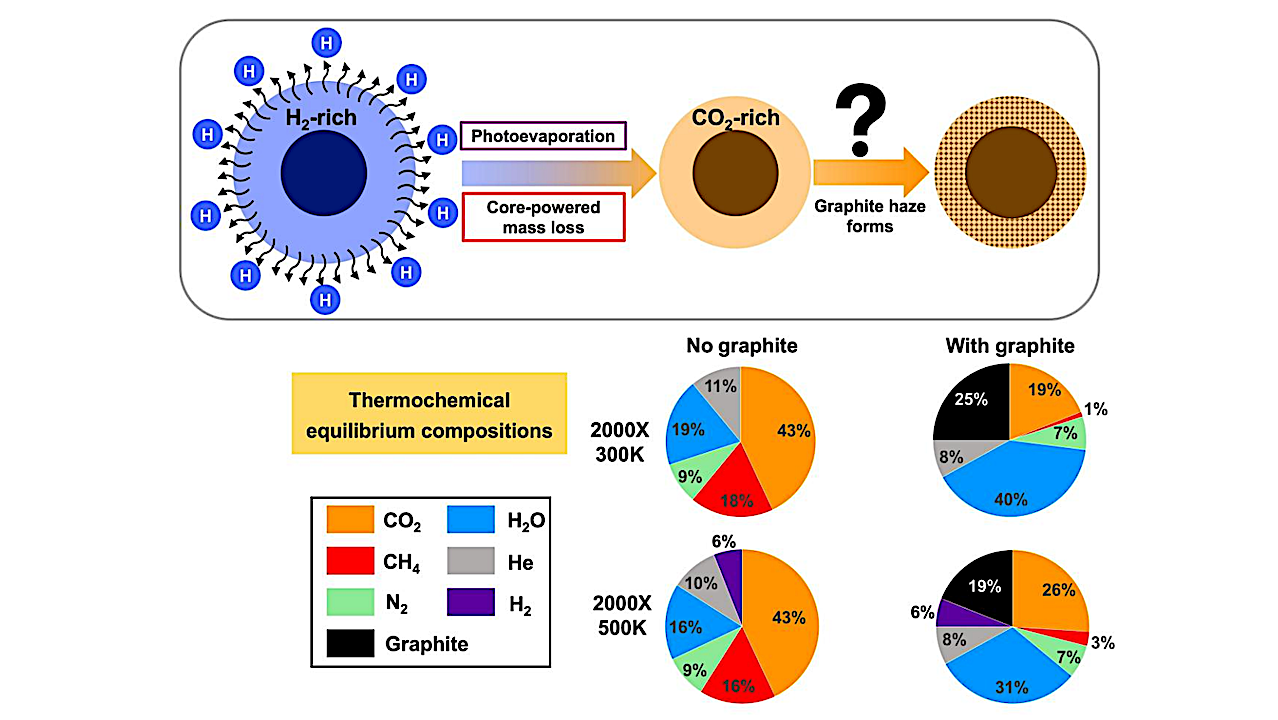The upper panel illustrates the mass loss processes and potential formation of graphite in sub-Neptune atmospheres within the graphitestability regime. The lower panel presents the atmospheric compositions calculated from the thermochemical equilibrium model without and with graphite. — astro-ph.EP
Super-Earths and sub-Neptunes are the most common exoplanets, with a “radius valley” suggesting that super-Earths may form by shedding sub-Neptunes’ gaseous envelopes.
Exoplanets that lie closer to the super-Earth side of the valley are more likely to have lost a significant fraction of their original H/He envelopes and become enriched in heavier elements with CO2 gaining in abundance. It remains unclear which types of haze would form in such atmospheres, potentially significantly affecting spectroscopic observations.
To investigate this, we performed laboratory simulations of two CO2-rich gas mixtures (with 2000 times solar metallicity at 300 K and 500 K). We found that under plasma irradiation, organic hazes were produced at both temperatures with higher haze production rate at 300 K probably because condensation occurs more readily at lower temperature. Gas-phase analysis demonstrates the formation of various hydrocarbons, oxygen- and nitrogen-containing species, including reactive gas precursors like C2H4, CH2O, and HCN, for haze formation.
The compositional analysis of the haze particles reveals various functional groups and molecular formulas in both samples. The 500 K haze sample has larger average molecular sizes, higher degree of unsaturation with more double or triple bonds presence, and higher nitrogen content incorporated as N-H, C=N bonds, indicating different haze formation pathways.
These findings not only improve the haze formation theories in CO2-rich exoplanet atmospheres but also offer important implications for the interpretation of future observational data.
Sai Wang, Zhengbo Yang, Chao He, Haixin Li, Yu Liu, Yingjian Wang, Xiao’ou Luo, Sarah E. Moran, Cara Pesciotta, Sarah M. Hörst, Julianne I. Moses, Véronique Vuitton, Laurène Flandinet
Subjects: Earth and Planetary Astrophysics (astro-ph.EP)
Cite as: arXiv:2508.05974 [astro-ph.EP] (or arXiv:2508.05974v1 [astro-ph.EP] for this version)
https://doi.org/10.48550/arXiv.2508.05974
Focus to learn more
Submission history
From: Sai Wang
[v1] Fri, 8 Aug 2025 03:17:11 UTC (1,130 KB)
https://arxiv.org/abs/2508.05974
Astrobiology,
